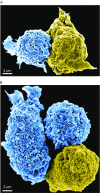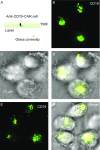Chimeric antigen receptor (CAR)-modified natural killer cell-based immunotherapy and immunological synapse formation in cancer and HIV
- PMID: 28488245
- PMCID: PMC5712291
- DOI: 10.1007/s13238-017-0415-5
Chimeric antigen receptor (CAR)-modified natural killer cell-based immunotherapy and immunological synapse formation in cancer and HIV
Erratum in
-
Erratum to: Chimeric antigen receptor (CAR)-modified natural killer cell-based immunotherapy and immunological synapse formation in cancer and HIV.Protein Cell. 2018 Oct;9(10):902. doi: 10.1007/s13238-017-0427-1. Protein Cell. 2018. PMID: 28646361 Free PMC article. No abstract available.
Abstract
Cytotoxic T lymphocytes (CTLs) and natural killer (NK) cells contribute to the body's immune defenses. Current chimeric antigen receptor (CAR)-modified T cell immunotherapy shows strong promise for treating various cancers and infectious diseases. Although CAR-modified NK cell immunotherapy is rapidly gaining attention, its clinical applications are mainly focused on preclinical investigations using the NK92 cell line. Despite recent advances in CAR-modified T cell immunotherapy, cost and severe toxicity have hindered its widespread use. To alleviate these disadvantages of CAR-modified T cell immunotherapy, additional cytotoxic cell-mediated immunotherapies are urgently needed. The unique biology of NK cells allows them to serve as a safe, effective, alternative immunotherapeutic strategy to CAR-modified T cells in the clinic. While the fundamental mechanisms underlying the cytotoxicity and side effects of CAR-modified T and NK cell immunotherapies remain poorly understood, the formation of the immunological synapse (IS) between CAR-modified T or NK cells and their susceptible target cells is known to be essential. The role of the IS in CAR T and NK cell immunotherapies will allow scientists to harness the power of CAR-modified T and NK cells to treat cancer and infectious diseases. In this review, we highlight the potential applications of CAR-modified NK cells to treat cancer and human immunodeficiency virus (HIV), and discuss the challenges and possible future directions of CAR-modified NK cell immunotherapy, as well as the importance of understanding the molecular mechanisms of CAR-modified T cell- or NK cell-mediated cytotoxicity and side effects, with a focus on the CAR-modified NK cell IS.
Keywords: HIV; cancer; chimeric antigen receptor; immunological synapse; immunotherapy; natural killer cell.
Figures


Similar articles
-
Reformation in chimeric antigen receptor based cancer immunotherapy: Redirecting natural killer cell.Biochim Biophys Acta Rev Cancer. 2018 Apr;1869(2):200-215. doi: 10.1016/j.bbcan.2018.01.005. Epub 2018 Jan 31. Biochim Biophys Acta Rev Cancer. 2018. PMID: 29378229 Review.
-
CAR-NK Cells: From Natural Basis to Design for Kill.Front Immunol. 2021 Dec 14;12:707542. doi: 10.3389/fimmu.2021.707542. eCollection 2021. Front Immunol. 2021. PMID: 34970253 Free PMC article. Review.
-
The Role of Immunological Synapse in Predicting the Efficacy of Chimeric Antigen Receptor (CAR) Immunotherapy.Cell Commun Signal. 2020 Aug 25;18(1):134. doi: 10.1186/s12964-020-00617-7. Cell Commun Signal. 2020. PMID: 32843053 Free PMC article. Review.
-
Engineering Natural Killer Cells for Cancer Immunotherapy.Mol Ther. 2017 Aug 2;25(8):1769-1781. doi: 10.1016/j.ymthe.2017.06.012. Epub 2017 Jun 28. Mol Ther. 2017. PMID: 28668320 Free PMC article. Review.
-
CAR-T and CAR-NK as cellular cancer immunotherapy for solid tumors.Cell Mol Immunol. 2024 Oct;21(10):1089-1108. doi: 10.1038/s41423-024-01207-0. Epub 2024 Aug 12. Cell Mol Immunol. 2024. PMID: 39134804 Free PMC article. Review.
Cited by
-
Scalable process development of NK and CAR-NK expansion in a closed bioreactor.Front Immunol. 2024 Jul 24;15:1412378. doi: 10.3389/fimmu.2024.1412378. eCollection 2024. Front Immunol. 2024. PMID: 39114666 Free PMC article.
-
CAR-NK Cells Effectively Target SARS-CoV-2-Spike-Expressing Cell Lines In Vitro.Front Immunol. 2021 Jul 23;12:652223. doi: 10.3389/fimmu.2021.652223. eCollection 2021. Front Immunol. 2021. PMID: 34367128 Free PMC article.
-
Combination Cancer Therapy Using Chimeric Antigen Receptor-Engineered Natural Killer Cells as Drug Carriers.Mol Ther. 2017 Dec 6;25(12):2607-2619. doi: 10.1016/j.ymthe.2017.08.010. Epub 2017 Aug 19. Mol Ther. 2017. PMID: 28919377 Free PMC article.
-
In vitro machine learning-based CAR T immunological synapse quality measurements correlate with patient clinical outcomes.PLoS Comput Biol. 2022 Mar 18;18(3):e1009883. doi: 10.1371/journal.pcbi.1009883. eCollection 2022 Mar. PLoS Comput Biol. 2022. PMID: 35303007 Free PMC article.
-
Efficacy of third-party chimeric antigen receptor modified peripheral blood natural killer cells for adoptive cell therapy of B-cell precursor acute lymphoblastic leukemia.Leukemia. 2020 Apr;34(4):1102-1115. doi: 10.1038/s41375-019-0613-7. Epub 2019 Nov 19. Leukemia. 2020. PMID: 31745215
References
Publication types
MeSH terms
Substances
Grants and funding
LinkOut - more resources
Full Text Sources
Other Literature Sources
Medical

